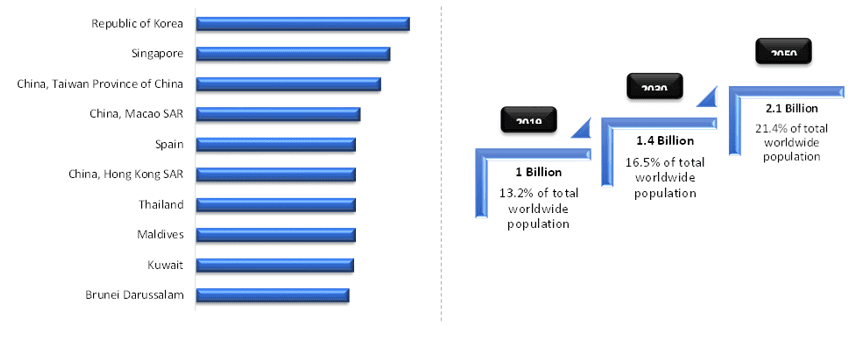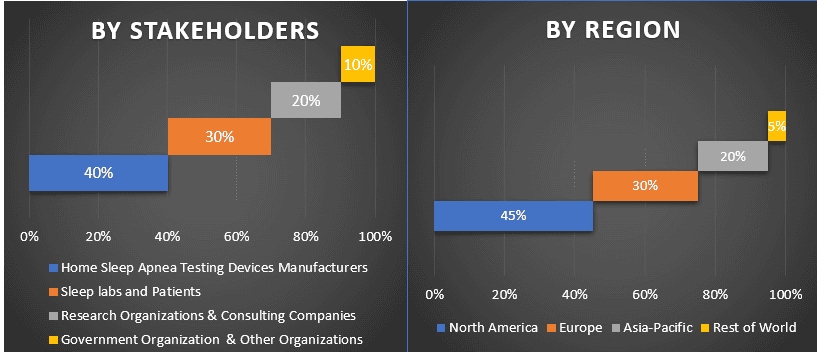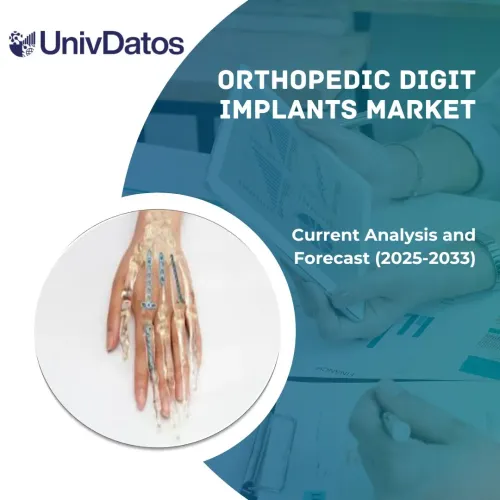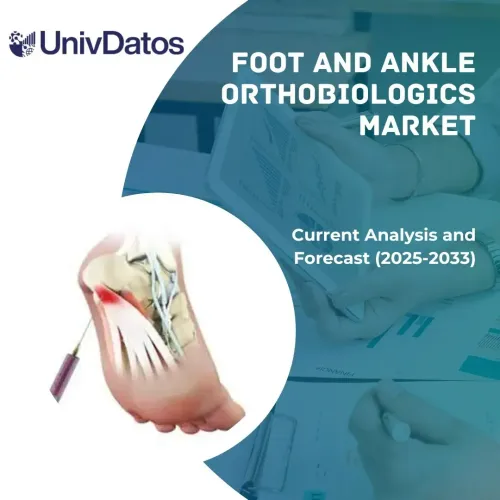- Home
- About Us
- Industry
- Services
- Reading
- Contact Us
Home Sleep Apnea Testing Devices Market: Current Analysis and Forecast (2021-2027)
Emphasis on Portability Type (Portable and Stationary); Structure Type (Wired and Non-wired); Device Type (Type 1, Type 2, Type 3, Type 4); Regions/Country

Global Home Sleep Apnea Testing Device Market is anticipated to grow with an elevated CAGR of around 6% over the forecast period (2021-2027). Sleep Apnea is a serious sleep disorder in which breathing stops repeatedly the whole night. Basically, it is of 3 types: obstructive sleep disorder, central sleep disorder, and complex sleep disorder. Obstructive sleep disorder is the most common form of sleep apnea in which throat muscles relax due to which person can’t breathe.
According to the United Nations, the global population aged 60 years or over was numbered 962 million in 2017 and is expected to reach nearly 2.1 billion by 2050. This rapidly growing geriatric population base is an indication of the growing prevalence of various age-related problems including hypertension, diabetes, congestive heart failure, among others. For instance, as per CDC, 34.1 million adults aged 18 years or older, or 13.0% of all US adults had diabetes. Owing to the growing prevalence of these chronic illnesses there is an increase in the number of elderly people suffering from obstructive sleep apnea which in turn is contributing to the growth of the home sleep apnea testing devices market.
Furthermore, the home sleep apnea testing market is anticipated to grow on account of the growing technological advancement, a large number of ongoing research activities in this field, rising government and public-private investments, and various advantages associated with the implementation of home sleep apnea testing devices such as it make detecting sleep apnea easier, more accurate and less expensive. However, some of the restraints in the market including the stringent regulatory framework and economic & clinical consequences of sleep apnea are impeding the growth of this market all over the world.
Countries with the largest percentage share of older persons aged 65 years or over, 2019-2050

Compumedics Limited, Natus Medical Inc., Koninklijke Philips N.V., SOMNOmedics GmbH, ResMed, Itamar Medical, Nox Medical, SleepMed Incorporated, CleveMed, Cadwell Industries, Inc. are some of the prominent players operating in the home sleep apnea testing device market. Several M&As along with partnerships have been undertaken by these players to facilitate customers with home sleep apnea testing devices.
Insights Presented in the Report
“Amongst Portability Type, portable device segment holds the major share”
Based on Portability, the home sleep apnea testing devices market is bifurcated into portable and stationary devices. The portable device segment accounted for a significant market share in 2020 and it is estimated that it will grow rapidly during the projected timeframe as these portable testing devices offer enhanced diagnostic performance, reliability, and satisfaction to the patients. Further, the demand for portable devices among the geriatric population is increasing as it is easy to use. The benefits of this device are many such as it reduces the time, is easy to use and handle, and generates fully digitalized reports within a minute which helps the geriatric age people to manage this device.
“Amongst Structure, non-wired segment holds the major share”
Based on the structure, the home sleep apnea testing devices market is divided into Wired and Non-Wired. The Non-Wired segment occupied the major share of the home sleep apnea testing devices market in 2020 and it is expected to grow with a substantial CAGR in the upcoming years. The non-wired device has advantages such as, it is easy to use, cost-effective, and comfortable to wear at the night for good sleep. Additionally, this non-wired device has advanced in-built biosensors that improve patient comfort which in turn is propelling the demand for various non-wired products. To cater to the growing demand for these devices, market players are focusing on launching new and advanced non-wired sleep apnea devices. For example, Philips launched Philips NightBalance, a prescription sleep position therapy device designed for patients with positional obstructive sleep apnea (OSA). A mask-free alternative to existing positional OSA treatments, Philips NightBalance is a clinically-validated positional therapy that uses gentle vibrations to encourage users to alter their sleeping positions to help prevent apneas.
“Amongst Device Type, Type 3 segment holds the major share”
Based on Device Type, the market is fragmented into Type 1, Type 2, Type 3, and Type 4. In 2020, the Type 3 segment grabbed a considerable market share, and it is expected to grow at a significant CAGR during the forecast period. Type 3 device is cost-effective as compared to polysomnography (PSG) devices. It provides high effectiveness and efficiency in the diagnosis of obstructive sleep apnea to the patient. Also, Type 3 has various other functions as it detects ECG or heart rate, oxygen saturation as well as channels of respiratory movement and airflow. Moreover, an increase in the production of the type 3 device type subsequently drives the market. For example, Cadwell re-introduced ApneaTrak home sleep apnea testing devices for Type 3 sleep studies. ApneaTrak offers a customizable experience with non-proprietary inputs.
“North America represents one of the largest markets of home sleep apnea testing device market”
For a better understanding of the market dynamics of the home sleep apnea testing device market, a detailed analysis was conducted for different regions across the globe including North America (the U.S, Canada, and the Rest of North America), Europe (Germany, France, United Kingdom, Italy, and Rest of Europe), Asia-Pacific (China, India, Australia, Japan, and Rest of APAC), Rest of World has been conducted. North America constitutes a major market for the home sleep apnea testing device market industry owing to strong healthcare infrastructure and growing adoption of home sleep apnea testing devices in the region.
Reasons to buy this report:
- The study includes market sizing and forecasting analysis validated by authenticated key industry experts
- The report presents a quick review of overall industry performance at one glance
- The report covers an in-depth analysis of prominent industry peers with a primary focus on key business financials, product portfolio, expansion strategies, and recent developments
- Detailed examination of drivers, restraints, key trends, and opportunities prevailing in the industry
- The study comprehensively covers the market across different segments
- Deep dive regional level analysis of the industry
Customization Options:
The global home sleep apnea testing device market can further be customized as per the requirement or any other market segment. Besides this, UMI understands that you may have your own business needs, hence feel free to connect with us to get a report that completely suits your requirements.
Table of Content
Analyzing the historical market, estimation of the current market, and forecasting the future market of the global home sleep apnea testing device market were the three major steps undertaken to create and analyze the adoption of home sleep apnea testing device in major regions globally. Exhaustive secondary research was conducted to collect the historical market numbers and estimate the current market size. Secondly, to validate these insights, numerous findings and assumptions were taken into consideration. Moreover, exhaustive primary interviews were also conducted, with industry experts across the value chain of the global home sleep apnea testing device market. Post assumption and validation of market numbers through primary interviews, we employed a top-down/bottom-up approach to forecasting the complete market size. Thereafter, market breakdown and data triangulation methods were adopted to estimate and analyze the market size of segments and sub-segments the industry pertains to. Detailed methodology is explained below:
Seek More Details About Research Methodology
Analysis of Historical Market Size
Step 1: In-Depth Study of Secondary Sources:
Detail secondary study was conducted to obtain the historical market size of the home sleep apnea testing device through company internal sources such as annual report & financial statements, performance presentations, press releases, etc., and external sources including journals, news & articles, government publications, competitor publications, sector reports, third-party database, and other credible publications.
Step 2: Market Segmentation:
After obtaining the historical market size of the home sleep apnea testing device market, we conducted a detailed secondary analysis to gather historical market insights and share for different segments & sub-segments for major regions. Major segments included in the report as portability type, structure, and device type. Further country-level analyses were conducted to evaluate the overall adoption of home sleep apnea testing device across the globe.
Step 3: Factor Analysis:
After acquiring the historical market size of different segments and sub-segments, we conducted a detailed factor analysis to estimate the current market size of the home sleep apnea testing device. Further, we conducted factor analysis using dependent and independent variables such as growing advancements in technology and the increasing prevalence of sleep disorders. A thorough analysis was conducted for demand and supply-side scenarios considering top partnerships, merger and acquisition, business expansion, and product launches in the home sleep apnea testing device sector across the globe.
Current Market Size Estimate & Forecast
Current Market Sizing: Based on actionable insights from the above 3 steps, we arrived at the current market size, key players in the home sleep apnea testing device market, and market shares of the segments. All the required percentage shares split, and market breakdowns were determined using the above-mentioned secondary approach and were verified through primary interviews.
Estimation & Forecasting: For market estimation and forecast, weights were assigned to different factors including drivers & trends, restraints, and opportunities available for the stakeholders. After analyzing these factors, relevant forecasting techniques i.e., top-down/bottom-up approach was applied to arrive at the market forecast about 2027 for different segments and subsegments across the major markets globally. The research methodology adopted to estimate the market size encompasses:
- The industry’s market size, in terms of value (US$) and the adoption rate of home sleep apnea testing device across the major markets domestically
- All percentage shares, splits, and breakdowns of market segments and sub-segments
- Key players in the home sleep apnea testing device market in terms of products offered. Also, the growth strategies adopted by these players to compete in the fast-growing market
Market Size and Share Validation
Primary Research: In-depth interviews were conducted with the Key Opinion Leaders (KOLs) including Top Level Executives (CXO/VPs, Sales Head, Marketing Head, Operational Head, and Regional Head, Country Head, etc.) across major regions. Primary research findings were then summarized, and statistical analysis was performed to prove the stated hypothesis. Inputs from primary research were consolidated with secondary findings, hence turning information into actionable insights.
Split of Primary Participants in Different Regions

Market Engineering
Data triangulation technique was employed to complete the overall market estimation and to arrive at precise statistical numbers of each segment and sub-segment of the home sleep apnea testing device market. Data was split into several segments & sub-segments post studying various parameters and trends in the areas of portability type, structure, and device type of the home sleep apnea testing device market.
The main objective of the Home sleep apnea testing device Market Study
The current & future market trends of home sleep apnea testing device were pinpointed in the study. Investors can gain strategic insights to base their discretion for investments from the qualitative and quantitative analysis performed in the study. Current and future market trends were determined the overall attractiveness of the market at a regional level, providing a platform for the industrial participant to exploit the untapped market to benefit as a first-mover advantage. Other quantitative goals of the studies include:
- Analyze the current and forecast market size of home sleep apnea testing device in terms of value (US$). Also, analyze the current and forecast market size of different segments and sub-segments
- Segments in the study include areas of portability type, structure, and device type
- Define and analysis of the regulatory framework for the home sleep apnea testing device industry
- Analyze the value chain involved with the presence of various intermediaries, along with analyzing customer and competitor behaviors of the industry
- Analyze the current and forecast market size of the home sleep apnea testing device market for the major region
- Major regions studied in the report include North America, Europe, Asia-Pacific and Rest of the world
- Company profiles of the home sleep apnea testing device market and the growth strategies adopted by the market players to sustain in the fast-growing market
Deep dive regional level analysis of the industry
Related Reports
Customers who bought this item also bought










